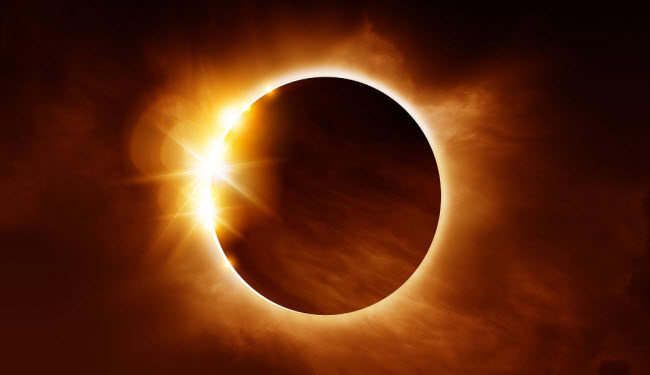A solar eclipse is a unique natural phenomenon that occurs when the Moon passes between the Earth and the Sun, casting its shadow on us. This event happens approximately every six months. Depending on the alignment of the Moon, it can result in a total eclipse, where the Sun’s disk is completely obscured, or a partial or annular eclipse, where only part of the Sun is covered. In ancient cultures, solar eclipses were often attributed to supernatural causes and viewed as omens. It wasn’t until later that their scientific understanding began to take shape, with predictions made by astronomers in China as early as the 4th century BCE. Today, with current technological advancements, solar eclipses can be predicted with high accuracy. It is always recommended to wear special eye protection to avoid any potential damage while observing the Sun.
Types of Solar Eclipses
There are four main types of solar eclipses: total, annular, partial, and hybrid. Each type has its own characteristics:
Total Solar Eclipse
A total solar eclipse is a rare event where the Moon completely covers the Sun’s disk. Although the Sun’s diameter is approximately 400 times greater than that of the Moon, the Moon is on average about 400 times closer to Earth than the Sun. As a result, when these celestial bodies align perfectly, the Moon can cover the Sun completely. On average, a total eclipse occurs somewhere on Earth approximately every 18 months. During this event, the Moon’s shadow falls on a specific area of the Earth. Those fortunate enough to be in this path will see the Sun’s disk diminish to a crescent while the dark shadow of the Moon moves towards them. When the Sun is fully obscured, the Sun’s outer atmosphere, or corona, becomes visible. The total eclipse can last up to 7 minutes and 31 seconds, though most total eclipses are shorter.
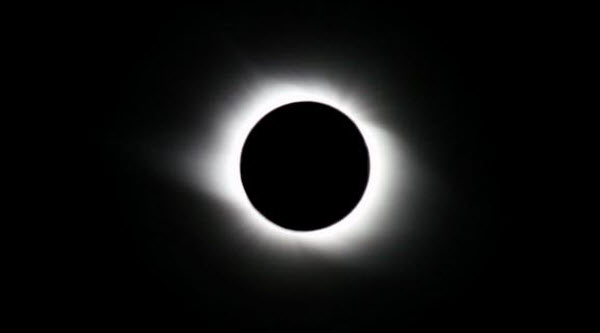
Partial Solar Eclipse
A partial solar eclipse occurs when only a portion of the Sun’s disk is covered by the Moon’s shadow. In this case, a part of the Sun always remains visible. This partial coverage can create a resemblance to the Sun’s appearance at the poles under normal conditions, even though the phenomenon can occur far from these locations. Individuals located thousands of kilometers from the path of the total eclipse can still witness a partial eclipse. The closer one is to the path of the total eclipse, the greater the degree of obscuration.
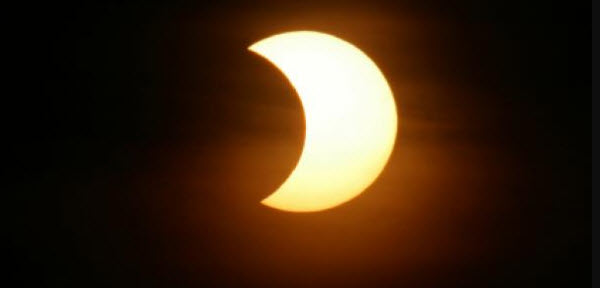
Annular Solar Eclipse
An annular solar eclipse is a spectacular and rare event where the sky darkens slightly, and a type of “false dawn” appears, with part of the Sun’s light still visible. This type of eclipse is a subtype of a partial eclipse. The maximum duration of an annular eclipse is 12 minutes and 30 seconds. Although the Moon passes centrally across the Sun, it is too small to cover the entire Sun due to its elliptical orbit around Earth. If you are lucky enough to witness this phenomenon, you will see the “ring of fire” surrounding the Moon.
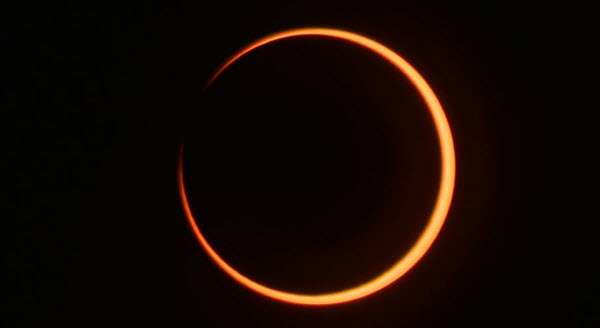
Hybrid Solar Eclipse
A hybrid solar eclipse, also known as an annular-total eclipse, occurs when the Moon’s distance from Earth is such that the eclipse transitions between annular and total. It starts as an annular eclipse and becomes total as the Earth’s curvature brings the Moon’s shadow to cover the Sun. As the Moon appears to pass directly in front of the Sun, hybrid eclipses are also referred to as central eclipses to distinguish them from partial eclipses.
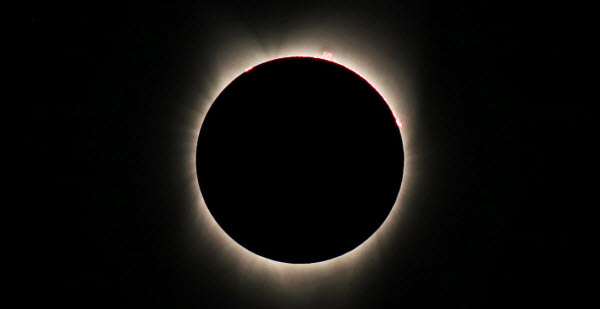
Overall, solar eclipses are about 28% total, 35% partial, 32% annular, and only 5% hybrid.
Predicting Solar Eclipses
Solar eclipses do not occur with every new Moon because the Moon’s orbit is tilted by slightly more than 5 degrees relative to Earth’s orbit around the Sun. Thus, the Moon’s shadow usually passes above or below Earth. However, eclipses generally occur at least twice a year (sometimes up to five times) when the Moon aligns perfectly with Earth and the Sun at what is known as a node. Depending on the Moon’s distance from Earth and, to a lesser extent, Earth’s distance from the Sun, the type of central eclipse (total, annular, or hybrid) is determined.
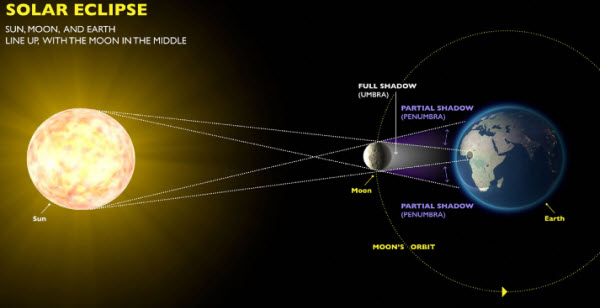
These alignments do not happen randomly. After a specific period, the same eclipse will repeat, known as the “Saros cycle,” a concept known since ancient Chaldean astronomers about 28 centuries ago. The term “Saros” means “repetition” and equals 18 years. After this time interval, the relative positions of the Sun and Moon to the node are almost the same as before. For example, on March 29, 2006, a total eclipse crossed parts of West and North Africa, then South Asia. After a Saros cycle, this will repeat on April 8, 2024, but across northern Mexico, the central and eastern United States, and Canada’s maritime provinces.
The next solar eclipse is expected to be a rare hybrid eclipse on April 20, 2023, a combination of an annular and total eclipse, with the “ring of fire” visible for a few seconds over the Indian and Pacific Oceans. The next total solar eclipse will occur on April 8, 2024, known as the “Great North American Eclipse,” visible across North and Central America.
How to Safely Observe a Solar Eclipse
It is crucial to never look directly at the Sun through binoculars, a telescope, or the naked eye without proper protection. Astronomers and photographers use special filters for safe viewing during solar eclipses and other solar phenomena.
One safe method to observe a solar eclipse is by constructing a pinhole camera. This involves using a small hole to project an image of the Sun onto a screen placed about a meter behind the hole. Binoculars or a well-mounted telescope can also project an enlarged image of the Sun onto a white card. The further the telescope is from the card, the sharper the image will be. This method allows you to view sunspots and observe that the Sun appears darker around its edges. This method is safe as long as you do not look directly at the Sun’s bright surface.

Appropriate solar observation tools or filters include a “Mylar filter,” specifically designed for solar observation, and welding goggles available at welding supply stores. It is always essential to test these filters before the eclipse. Inappropriate protection includes regular sunglasses, old color-negative films, black-and-white films without silver, neutral density photographic filters, and polarizing filters. While these materials have low visible light transmission, they allow a high and unacceptable level of near-infrared radiation that can cause thermal burns to the retina. The Sun will appear dim, and nothing will be visible clearly.
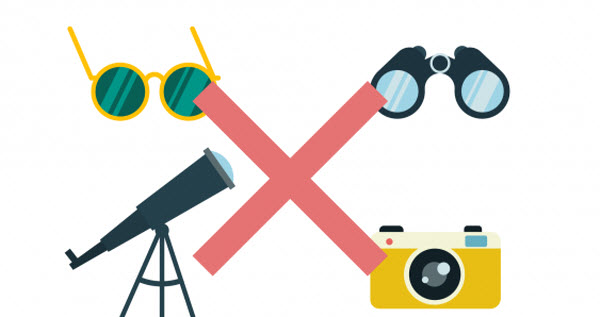
The only time you can safely look directly at the Sun is during the total eclipse when the Sun’s disk is completely covered. During these precious seconds or minutes, the stunning corona surrounding the dark Sun will appear as a brilliant white light with a shimmering, sometimes continuous, appearance. Occasionally, long rays will extend from it in three or four directions. However, once the Sun begins to reappear, the corona fades quickly, and you will need to protect your eyes again.
Eclipses and Ancient Cultures
The earliest recorded solar eclipse occurred more than four thousand years ago in China. At that time, it was believed that a dragon was trying to devour the Sun. Astronomers in the royal court would shoot arrows, beat drums, and make noises to scare it away. According to Greek historian Herodotus, a five-year war between the Lydians and Medes ended when the Sun vanished as the conflict was about to enter its sixth year. Believing it to be a sign from the heavens, the warring parties called a truce, which was cemented through a double marriage. Herodotus wrote: “Without some strong bonds, little safety can be found in the oaths of men.” The phrase “scared to death” is derived from a total solar eclipse witnessed by Emperor Louis of Bavaria on May 5, 840 CE, which lasted over five minutes. As the Sun began to reappear, Louis died, frightened by the event.

Over the years, astronomers have learned a great deal from studying solar eclipses. By the 18th century, these events provided a wealth of astronomical data, though acquiring this information was not always easy. Astronomer Samuel Williams from Harvard University led an expedition to Penobscot Bay in Maine to observe a total solar eclipse on October 27, 1780. Unfortunately, this eclipse occurred during the Revolutionary War, and Penobscot Bay was behind enemy lines. However, the British allowed him a safe passage, citing science over political differences. Additionally, on August 18, 1868, French astronomer Pierre Janssen discovered a new chemical element, named “helium” after the Greek word “Helios” (Sun), which was not recognized on Earth until 1895.
During a total solar eclipse, some of the brightest stars and planets can be observed in the darkened sky. Under these conditions, astronomers tested part of Albert Einstein’s general theory of relativity, which predicted that light from stars behind the Sun would bend in a specific manner as it passed near the Sun. The positions of stars photographed near the Sun’s edge during the total eclipse on May 29, 1919, were compared to images of the same area taken at night, strongly supporting Einstein’s theory.
